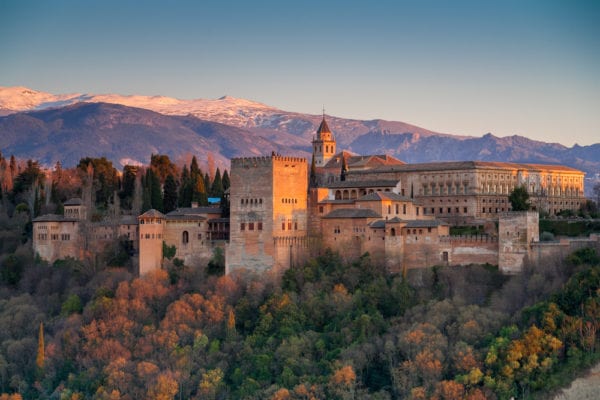The Moorish legacy in Andalucía
The Moorish legacy in Andalucía
The Moorish legacy in Andalucía
-
Hannah
-
Hannah

Each of the Spanish regions has its own unique culture and history; but for me, the most beautiful and fascinating of them all is Andalucía. This southernmost region has a distinctive look and feel influenced by a history of Moorish occupation. It is a place characterised by legacy, and thus was the ideal setting for my recent romance trilogy: Indiscretion, Masquerade and Legacy.
The Moors were descended from Berber and Arab tribes of North Africa, and they ruled ‘Al-Andalus’, modern-day Andalucía, from 711 to 1492. More than 500 years later, their presence is still felt. Here are three important legacies the Moors left in Andalucía:
Cuisine
Under Moorish rule, sophisticated irrigation systems were developed, which greatly improved agricultural output. Not only this, but the Moors brought with them crops which were then integrated into Andalucían farming – and, subsequently, into the cuisine. Orange, grapefruit, lemon, peach, apricot, fig, pomegranate, artichoke, almonds, carrot, coriander, saffron, sugar cane, rice… these were all brand-new flavours to be explored. Consider paella, for example, that staple of Spanish cuisine, and the almond taste in so many Andalucían desserts and pastries; it is thanks to the Moors’ introduction of rice and saffron and almonds that such recipes were ever conceived.

Cooking methods that are still in use today were also taught: fish coated in flour and then fried, for example. The Moors favoured salt and vinegar for food preservation; their influence can be seen today in the tapas dish boquerones en vinagre, anchovies marinated in vinegar.
Language
No doubt you know that Spanish is a Romance language: like French and Italian, it evolved from Latin between the sixth and ninth centuries. But did you know that in fact as many as 4,000 words Spanish words have Arabic roots, thanks to the Moorish rule? Most words that begin with ‘al’ are derived from Arabic, as does that most famous of Spanish expressions, ‘¡Ole!’
Hundreds of place names in Andalucía are derived from Arabic, such as Almería City (from Al-Meraya, the watchtower), Jaén City (from Jayyan, crossroads of caravans) and Sanlúcar de Barrameda (from shaluqa, meaning the Levant wind, and bar-am-ma’ida, water well of the plateau). Plenty of geographical features also have Arabic names, such as the River Guadalquivir (derived from Al-Wādĩ Al-Kabir, the big river).
Given names like Almudena, Fátima and Guadalupe can also be traced back to Arabic origins, as can Omar, Soraya, Zaida and Zahira. (Surnames are less commonly related to Arabic, because in the 15th and 16th centuries Muslims were persecuted and forced to adopt Christian family names.)
Architecture
Last but by no means least, the most striking of all the legacies…
Out in the countryside of Andalucia, through the north of Cádiz and Málaga provinces, you find the pueblos blancos. Literally translated, they are the ‘white villages’, so-called because the villagers whitewash their homes. The result is luminous buildings that stand out in the landscape, reflecting the light – a contrast of brilliant white against the azure sky that is beautiful and unforgettable. The whitewashing tradition was begun by the Moors, who knew, from their African heritage, that it reflected the blazing sunrays and cooled the buildings.

Within and beyond these villages, you will find Moorish influence in so much of the architecture, in the colours, the materials, the symmetry, the domes, the elegant arches. The two most striking examples of Moorish architecture that have endured in Andalucía are the Alhambra palace in Granada and the Alcázar in Seville. You can read all about them in these articles from my blog: https://hannahfielding.net/staging/1129/the-alcazar-seville-a-setting-for-indiscretion/; https://hannahfielding.net/staging/1129/tales-of-the-alhambra/; and https://hannahfielding.net/staging/1129/the-hall-of-the-abencerrages/.

The Moors, then, have left a lasting legacy in Andalucía, and it is one that inspired me greatly as I wrote my Andalucían Nights novels. You will find references to the Moors throughout the books, with regard to everything from art to legends.
But what of the great spirit of Andalucía, the fiery passion of its people – does that come from Moorish ancestors? I will let you decide, and in the meantime I will leave you smiling, I hope, with a little joke from Salvador in Indiscretion:
‘Didn’t you know that in Andalucia, love is as inconstant as it is passionate and jealous? A liking for the harem has been handed down to us by centuries of Moorish civilisation.’
One of the views that fascinated me while at the Alhambra was the Sierra Nevada mountains. The clearest view was from the gardens at the top of the property. I paid special attention when told that the water used to irrigate the plant life came from snow melt in the Sierras. The reuse of water from one level to the next fascinated me as much as anything else I learned about Alhambra.
Thanks for sharing the photo.
As I understand it, the Moors put in place extensive irrigation systems, building on what the Romans had left behind. All that work here for lush gardens – well worthwhile, I think!